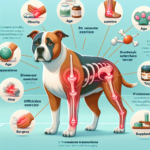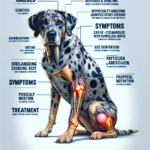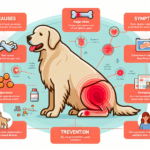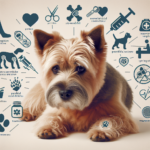Miniature Pinscher Joint Pain: Causes, Symptoms, Prevention, and Treatment
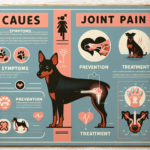
Introduction
The Miniature Pinscher, often affectionately referred to as the “Min Pin,” is a small breed of dog known for its spirited personality and sleek, elegant appearance. Originating in Germany, the breed was initially developed to hunt vermin, particularly rats, in homes and stables. Despite its small size, the Miniature Pinscher is a robust and energetic dog, often described as a “big dog in a small body.” With a history dating back several centuries, the breed has become a popular companion animal, admired for its intelligence, agility, and fearless demeanor.
Like many purebred dogs, Miniature Pinschers are prone to certain health issues. Common concerns include patellar luxation, Legg-Calvé-Perthes disease, and various eye conditions. However, one of the most significant health issues that can affect the quality of life for a Miniature Pinscher is joint pain. Joint health is crucial for maintaining the breed’s active lifestyle and overall well-being.
Breed-Specific Joint Pain Risks
Genetic Predisposition
Miniature Pinschers are genetically predisposed to several joint-related issues. One of the most common is patellar luxation, a condition where the kneecap dislocates from its normal position. This can cause significant discomfort and may lead to arthritis if not treated. Another genetic concern is Legg-Calvé-Perthes disease, a condition that affects the hip joint, leading to the degeneration of the femoral head. This can result in pain, lameness, and arthritis over time.
Age-Related Risks
As Miniature Pinschers age, they become more susceptible to joint pain and related issues. While younger dogs may experience joint problems due to genetic factors or injury, older dogs are more likely to develop arthritis. Owners should be particularly vigilant as their Miniature Pinscher approaches middle age, typically around 7-8 years old, as this is when age-related joint issues often begin to manifest.
Activity Level and Joint Stress
Miniature Pinschers are known for their high energy levels and love of physical activity. While regular exercise is essential for their overall health, excessive or inappropriate exercise can put undue stress on their joints. Activities that involve a lot of jumping or sudden changes in direction can be particularly hard on their joints, increasing the risk of injury and long-term joint problems.
Common Symptoms of Joint Pain in Miniature Pinschers
General Symptoms
- Limping: One of the most noticeable signs of joint pain is limping or favoring one leg over another.
- Stiffness: Dogs with joint pain may appear stiff, especially after resting or sleeping.
- Reluctance to Move: A dog experiencing joint pain may be hesitant to engage in activities they once enjoyed, such as running or jumping.
- Swelling: In some cases, the affected joint may appear swollen or feel warm to the touch.
- Behavioral Changes: Dogs in pain may become irritable, anxious, or less social.
Breed-Specific Symptoms
In Miniature Pinschers, symptoms of joint pain may be more subtle due to their stoic nature. Owners should watch for changes in gait, reluctance to climb stairs, or difficulty getting up from a lying position. Additionally, Miniature Pinschers may exhibit a “bunny hopping” gait when running, which can indicate hip issues.
When to Consult a Vet
If you notice any of the above symptoms in your Miniature Pinscher, it is essential to consult a veterinarian promptly. Early diagnosis and treatment can significantly improve the prognosis and quality of life for your dog. Persistent limping, noticeable pain, or any sudden changes in behavior should be addressed immediately.
Preventive Measures for Joint Health
Exercise Recommendations
Regular, moderate exercise is crucial for maintaining joint health in Miniature Pinschers. Activities such as walking, swimming, and gentle play are excellent options. Avoid high-impact activities like excessive jumping or running on hard surfaces, as these can exacerbate joint issues. Aim for at least 30 minutes of exercise daily, tailored to your dog’s age and physical condition.
Dietary Suggestions
A balanced diet rich in essential nutrients can support joint health. Look for dog foods that contain glucosamine and chondroitin, which help maintain cartilage health. Omega-3 fatty acids, found in fish oil supplements, can also reduce inflammation and support joint function. Always consult your veterinarian before adding supplements to your dog’s diet.
Weight Management
Maintaining a healthy weight is vital for reducing joint stress. Excess weight can exacerbate joint pain and lead to other health issues. Monitor your Miniature Pinscher’s weight regularly and adjust their diet and exercise routine as needed. Your veterinarian can provide specific guidelines based on your dog’s age, weight, and activity level.
Early Screening and Monitoring
Regular veterinary check-ups are essential for early detection of joint issues. Your vet may recommend screening tests such as X-rays or joint fluid analysis to identify problems before they become severe. Early intervention can significantly improve outcomes and prevent long-term damage.
Treatment Options for Joint Pain
Non-Surgical Treatments
Non-surgical treatments for joint pain in Miniature Pinschers include medications, physical therapy, and lifestyle adjustments. Common medications include non-steroidal anti-inflammatory drugs (NSAIDs) to reduce pain and inflammation. Physical therapy can help improve mobility and strengthen muscles around the affected joints. Lifestyle adjustments, such as providing a comfortable bed and avoiding stairs, can also alleviate pain.
Surgical Options
In severe cases, surgical intervention may be necessary. Common surgeries for joint pain include patellar luxation correction, hip replacement, and arthroscopy. These procedures can provide significant relief and improve the quality of life for dogs with advanced joint issues. Your veterinarian will discuss the best surgical options based on your dog’s specific condition.
Alternative Therapies
Alternative treatments such as acupuncture, hydrotherapy, and massage can also benefit Miniature Pinschers with joint pain. Acupuncture can help reduce pain and inflammation, while hydrotherapy provides low-impact exercise that strengthens muscles without stressing the joints. Massage therapy can improve circulation and reduce muscle tension, providing relief from joint pain.
Lifestyle and Management Tips
Daily Care Routine
A consistent daily care routine can help manage and alleviate joint pain in Miniature Pinschers. This routine might include gentle exercise, a balanced diet, and regular administration of any prescribed medications or supplements. Providing a comfortable, supportive bed and avoiding activities that stress the joints are also essential components of daily care.
Modifying the Home Environment
Making your home more comfortable for a dog with joint pain can significantly improve their quality of life. Consider installing ramps to help your dog navigate stairs or get onto furniture. Orthopedic beds provide additional support and comfort for sore joints. Ensure that food and water bowls are easily accessible to reduce strain on the neck and joints.
Long-Term Management
Long-term management of joint pain involves regular veterinary check-ups, ongoing weight management, and consistent use of any prescribed treatments or therapies. Keeping your Miniature Pinscher active and engaged with appropriate exercises and mental stimulation can also help maintain their overall well-being. Monitoring your dog’s condition and making adjustments as needed will ensure they remain happy and comfortable.
FAQs About Miniature Pinschers and Joint Pain
What are the early signs of joint pain in Miniature Pinschers?
Early signs of joint pain include limping, stiffness, reluctance to move, and changes in behavior. If you notice any of these symptoms, consult your veterinarian for a thorough evaluation.
Can joint pain in Miniature Pinschers be prevented?
While genetic factors cannot be entirely prevented, maintaining a healthy weight, providing appropriate exercise, and regular veterinary check-ups can help reduce the risk of joint pain and catch issues early.
Are there specific exercises that are better for Miniature Pinschers with joint pain?
Low-impact exercises such as walking and swimming are ideal for Miniature Pinschers with joint pain. Avoid high-impact activities like jumping or running on hard surfaces.
What dietary supplements can help with joint health?
Supplements containing glucosamine, chondroitin, and omega-3 fatty acids can support joint health. Always consult your veterinarian before adding supplements to your dog’s diet.
When should I consider surgery for my Miniature Pinscher’s joint pain?
Surgery is typically considered when non-surgical treatments are no longer effective, and the dog’s quality of life is significantly impacted. Your veterinarian will discuss the best surgical options based on your dog’s specific condition.
Conclusion
Joint pain is a significant concern for Miniature Pinschers, but with proper care and attention, it can be managed effectively. By understanding the breed-specific risks, recognizing early symptoms, and implementing preventive measures, owners can help ensure their Miniature Pinscher remains active and comfortable throughout their life. Regular veterinary check-ups and a proactive approach to joint health are essential for maintaining the well-being of this spirited and beloved breed.

